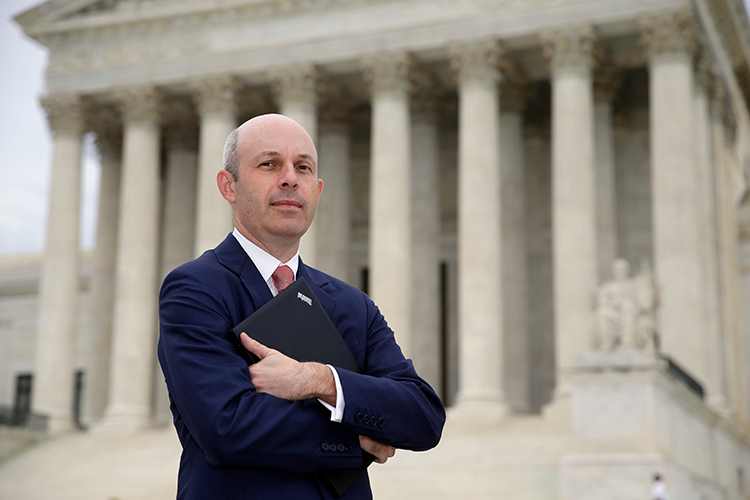2nd Circuit cites push notifications to jurors as one reason why Sarah Palin deserves new defamation trial

Former Alaska Gov. Sarah Palin, a Republican, is seen leaving court in New York in 2022. (Photo by Anthony Behar/Sipa USA via the Associated Press)
Former Alaska Gov. Sarah Palin, a Republican, is entitled to a new trial in her defamation case against the New York Times, partly because a jury finding of no liability was marred by push notifications received by jurors, a federal appeals court ruled Wednesday.
The 2nd U.S. Circuit Court of Appeals at New York said U.S. District Judge Jed Rakoff of the Southern District of New York wrongly intruded on the province of the jury when he ruled during deliberations that the case should be dismissed because of insufficient evidence that the newspaper and one of its editors acted with actual malice.
Rakoff allowed the jury to issue a verdict anyway, and it found no liability. But the verdict was marred by some of Rakoff’s decisions and by push notifications that some jurors received about Rakoff’s finding of no actual malice, the appeals court said in its Aug. 28 opinion.
Law360 covered the 2nd Circuit’s decision in favor of Palin, a Republican who was the 2008 vice presidential candidate. She had sued over a June 2017 editorial linking the shooting of a Democratic congresswoman with a digital crosshairs graphic published by Palin’s political action committee.
Rakoff’s law clerk had learned about the push notifications when interviewing jurors following the verdict to see whether they had problems understanding the legal instructions.
A push notification from a news application can appear at the top of a cellphone or on a lockscreen even when the app is closed, the 2nd Circuit explained.
Jurors said they were not prejudiced by the push notifications, which were “an unfortunate surprise” to Rakoff, the appeals court said. But Rakoff was wrong in concluding that the jury verdict was not prejudiced, the appeals court concluded.
“Given a judge’s special position of influence with a jury, we think a jury’s verdict reached with the knowledge of the judge’s already-announced disposition of the case will rarely be untainted, no matter what the jurors say upon subsequent inquiry,” the 2nd Circuit said. “We therefore conclude that a new trial is warranted on this basis.”
The 2nd Circuit panel also said Rakoff erred by excluding some evidence offered by Palin and by improper jury instructions.
The New York Times editorial had linked a 2011 shooting that wounded then-U.S. Rep. Gabby Giffords, a Democrat from Arizona, to a map by Palin’s political action committee showing targeted electoral districts in a crosshairs. Six people were killed in the shooting, including a federal judge.
The New York Times had declared that “the link to political incitement was clear,” even though the attack was viewed as stemming from the perpetrator’s mental illness, according to the 2nd Circuit.
The New York Times later issued corrections saying the crosshairs were placed over targeted electoral districts, not photos of politicians, and saying there was no established link between political rhetoric and the shooting.
Palin sued the New York Times and James Bennet, then the editorial page editor, who had written the sentence about the link to political incitement being clear.
The 2nd Circuit said Rakoff should have allowed evidence that Bennet’s brother, Michael Bennet, was a Colorado Democratic U.S. senator, that Bennet was involved in his brother’s 2010 reelection bid, that the crosshairs map targeted the districts of two Democrats in the House of Representatives who endorsed Bennet’s brother, and that Palin had endorsed the person running against Sen. Bennet.
The appeals court said the evidence was relevant, and it could lead a reasonable juror to infer that Bennet had “a reason to personally dislike Palin, and that it was therefore more likely that he intentionally or recklessly, rather than inadvertently, connected her” to the shooter who wounded Giffords.
Rakoff should also have allowed introduction of three prior New York Times opinion articles that could “be plausibly read” as casting significant doubt on links between the shooting and the crosshairs map, the 2nd Circuit said. Bennet had testified that he “must have read” the prior articles.
Judge John M. Walker Jr., an appointee of former President George H.W. Bush, wrote the panel opinion. It was the second time that the 2nd Circuit ruled in the case. Rakoff had previously tossed the case without a trial, but the appeals court ruled in 2019 that he followed the wrong procedure and reinstated the lawsuit.
The case is Palin v. New York Times Co.



